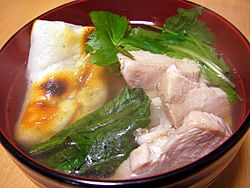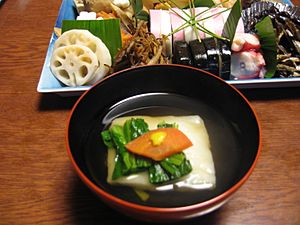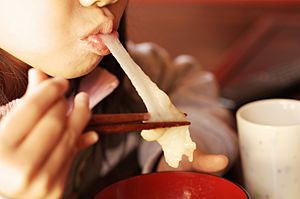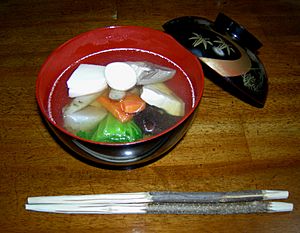Zōni facts for kids
 |
|
| Type | Soup |
|---|---|
| Place of origin | Japan |
| Main ingredients | mochi rice cakes |

Zōni (pronounced ZOH-nee) is a special Japanese soup that has soft, chewy mochi rice cakes inside. People often call it o-zōni by adding "o-", which is a polite way to speak in Japanese. This soup is a very important part of the Japanese New Year celebrations. It's usually eaten with other traditional New Year foods called osechi. How zōni is made can be different from one family to another, and it also changes a lot depending on which part of Japan you are in.
Contents
What Does Zōni Mean?
The name Zōni is written using two Japanese kanji characters. The first character, 雑, means "mixed" or "various." The second character, 煮, means "to simmer" or "to boil."
So, the name Zōni probably comes from the idea that this soup is made by boiling many different ingredients together. These ingredients can include mochi, vegetables, and even seafood. Long ago, among the samurai, this dish was sometimes called "Hōzō."
The History of Zōni
Many people believe that zōni first started with the samurai warriors. It's thought that they cooked this meal during battles in the field. They would boil mochi, vegetables, and dried foods together.
At first, zōni was a special meal just for samurai. But over time, it became a common food for everyone in Japan. It was even served as part of fancy samurai dinners called honzen ryōri, which shows how important it was to them.
The tradition of eating zōni on New Year's Day began around the end of the Muromachi period (1336–1573). People would offer this dish to the gods in a special ceremony on New Year's Eve.
Different Kinds of Zōni
Zōni has many different versions across Japan. The ingredients and how it's made can change a lot depending on the region.
Soup Base Variations
In many areas, like the Kantō region (where Tokyo is), zōni has a clear soup base called sumashi-jiru. This soup gets its flavor from dashi, which is a stock made from dried bonito flakes or kombu (a type of seaweed), along with soy sauce.
However, in the Kansai region and eastern Shikoku, zōni is made with a white miso paste stock. In some parts of Fukui Prefecture, they use a red miso stock. And in the Tottori-Izumo area, they even use a kind of red bean soup for their zōni.
Mochi Preparation Variations
The mochi itself is also prepared differently depending on the region. In the Kantō and Tōhoku regions, the mochi are cut into squares. They are then grilled until they are a little crispy before being added to the soup.
But in the Kansai and Chūgoku regions, people usually prefer round mochi that are simply boiled until soft. In most of the Kyushu region, round mochi is also popular, but whether it's grilled or boiled can still vary by specific area. In some places, if rice isn't grown much, people might even use taro root or tofu instead of mochi.
Extra Ingredients
Many different things can be added to zōni soup. Common additions include chicken, fish, or meatballs. You might also find leafy vegetables like komatsuna or spinach.
Other popular additions are mitsuba (a Japanese herb like parsley), kamaboko (fish cakes) such as naruto (which often has a pink swirl), and carrot flakes for extra color. Sometimes, a few flakes of yuzu peel are added for a fresh citrus smell. People might also sprinkle shichimi (a seven-spice chili mix) on top at the table for a little bit of heat.
See also
 In Spanish: Zōni para niños
In Spanish: Zōni para niños



